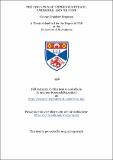The pyrolysis of triphenyimethane, carbazole and toluene
Abstract
In all the studies reported in the subsequent sections a common method of approach has been followed. As a preliminary to the kinetic work, detailed investigations have been made of the precise nature and stoichiometry of the decompositions occurring. Since the conditions chosen for the work involve low concentrations of reactants as a means of minimising secondary processes, the analytical techniques to determine the precise stoichiometry have faced considerable difficulties peculiar to each case investigated. The general techniques of gas analysis, ultra violet spectrophotometry, mass spectrometry, and chromatography have been enlisted to solve the problems involved. Although many of these techniques have been common to all three substances, the problems were sufficiently individual to merit their discussion in separate sections.
1. Triphenyl Methane
a. The pyrolytic decomposition of this substance yielded 9-phenyl fluorine and hydrogen in equimolecular proportions. A hydrocarbon C₂₃H₁₈ was also produced in a very small amount.
b. The decomposition proceeded by a first order mechanism, obeying the rate equation k=1.26 x 10¹⁴ e ⁻⁷¹, ¹°°/RT.
2. Carbazole
a. The thermal decomposition of this compound has been shown not to give the dimer 9:9’ of dicarbazyl under usual pyrolytic conditions.
b. It is more probably that hydrogen and a phenazine type of compound are produced by the reaction of two carbazyl radicals.
c. There appeared to be some heterogenous decomposition on the walls of the reactor during carbazole pyrolysis and a carbon coated surface is necessary.
d. The kinetic data obtained were rather scattered due to poor reproducibility, but first order rate constants are of a magnitude given by k = 10¹³e ⁷⁵,°°°/RT.
e. If the energy of activation is ascribed to the dissociation of the N-H link in the molecule, it is shown that the resonance energy of the radical is in rough agreement with expectations from other data.
3. Toluene.
a. Since two values for the energy of activation of the primary decomposition of toluene have been reported, a brief re-examination of the problem has been made, using the nitrogen carrier gas technique.
b. The value of 77.5 k.cals./mole found was in agreement with the previous work of Szwarc, and the products were those anticipated on the basis of his proposed mechanism
c. An examination is made of the papers by Szwarc³¹ and Steacie ⁴°
Type
Thesis, PhD Doctor of Philosophy
Collections
Items in the St Andrews Research Repository are protected by copyright, with all rights reserved, unless otherwise indicated.

